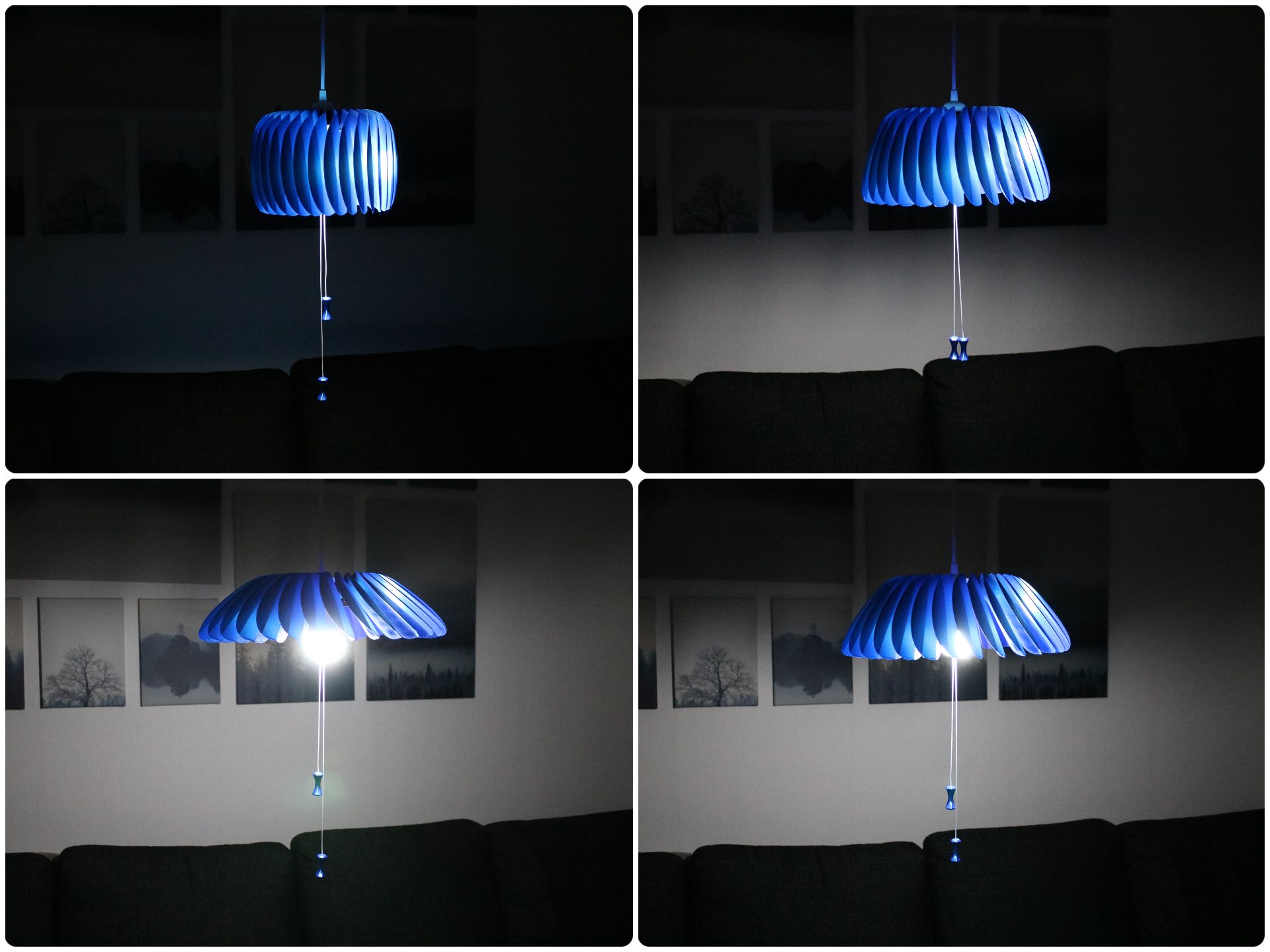
Adjustable lamp shade
prusaprinters
<p>An adjustable lampshade which acts as a mechanical dimmer.</p> <p>Designed around the IKEA HEMMA cord set but it should work on any socket with the same diameter (~40mm including the threads).</p> <p>If you want to try another socket, print the threadtest.stl model. If it fits on the socket and the socket has a length of at least 20mm (the threaded part) it should work fine.</p> <h3>Print instructions</h3><h3>Printing:</h3> <p>Since light bulbs get hot the parts should be printed using a filament with higher temperature resistance (not PLA).</p> <p>Use 0.2mm or lower layer height</p> <p>No supports needed</p> <p>The shader is available as multiple stls with 1, 2, 4 or 5 shaders aligned closely to make it easier to fit multiple shaders on the build plate. Use the version(s) that fits on your printer.</p> <p>The guide piece is optional. With it the strings become centered under the light bulb but there will be a bit more resistance when pulling the cords to adjust the shade. Without it pulling the cords will be a little easier but the lamp shade will tilt when adjusting it.</p> <h3>Required parts:</h3> <ul> <li>Base x1</li> <li>Screw x1</li> <li>Nut x1</li> <li>Top spacer x1</li> <li>Guide x1 (optional)</li> <li>End cap x2</li> <li>Shader x32</li> <li>1 meter inelastic string with diameter <2mm. I used 1.4mm window blind cord (also called lift cord).</li> <li>IKEA HEMMA cord set or similar. If you are planning to use another socket print the thread test model first to make sure the base will fit.</li> <li>LED light bulb, for example IKEA RYET E27 470 lumen</li> </ul> <h3>Preparation:</h3> <p>This is to make sure everything fits together and can move as intended. If something does not move easily it is probably due to a seam/blob/string and you should use a piece of fine sandpaper to make the affected area smooth.</p> <ul> <li>Put the screw on the base and make sure it can rotate easily</li> <li>Put the nut on the base and make sure it can move easily up and down on the rods</li> <li>Screw the screw into the nut and make sure it moves freely. If not either try to use some fine sanding paper or just keep screwing in/out to wear it out</li> <li>Make sure the top of the screw and spacer is flat (no protruding artefacts in the top layer). If not sand it down gently with a fine grit sanding paper.</li> </ul> <p><strong>Tip:</strong> When fully assembled there will be more pressure on the nut and screw which can make it hard to turn. This is easily fixed by lubricating the screw (threads, inside, top and bottom) and the threads of the nut with silicone spray. <strong><em>Do not do this when assembled and let the silicone spray dry before assembling. Do not use any oil or grease as lubrication.</em></strong></p> <h3>Assembly:</h3> <h5>Step 1</h5> <p><img alt="Step 1" src="https://i.imgur.com/2hae5Wf.png" width="100%"/></p> <p>Tie a simple knot at the middle of the string and pull the ends through the loops on the screw.</p> <h5>Step 2</h5> <p><img alt="Step 2" src="https://i.imgur.com/WLlw8Zh.png" width="100%"/></p> <p>Put the screw on the base and pull the strings through the rounded hole in the base.</p> <h5>Step 3</h5> <p><img alt="Step 3" src="https://i.imgur.com/yHgekgL.png" width="100%"/></p> <p>Turn the screw clockwise three quarters of a turn so the arrow points to the left.</p> <h5>Step 4</h5> <p><img alt="Step 4" src="https://i.imgur.com/y7pywMl.png" width="100%"/></p> <p>Put the nut on the screw. Make sure the lines on the nut and base as well as the arrows on the nut and screw are aligned.</p> <h5>Step 5</h5> <p><img alt="Step 5" src="https://i.imgur.com/Zmn6qEI.png" width="100%"/></p> <p>Pull the strings so the nut screws on to the screw.</p> <h5>Step 6</h5> <p><img alt="Step 6" src="https://i.imgur.com/3KOARjs.png" width="100%"/></p> <p>Put the top spacer and the base assembly onto the IKEA HEMMA (or other compatible) socket and screw the base in place to secure it.</p> <h5>Step 7</h5> <p><img alt="Step 7" src="https://i.imgur.com/DOm5gWu.png" width="100%"/></p> <p>Pull the strings through the guide. Make sure they do not get twisted inside the guide as this will increase resistance.</p> <h5>Step 8</h5> <p><img alt="Step 8" src="https://i.imgur.com/KOMBPjW.png" width="100%"/></p> <p>Insert the rounded hitch into the slot in the base next to the strings and turn it to slide in place.</p> <h5>Step 9</h5> <p><img alt="Step 9" src="https://i.imgur.com/Q5PPHkG.png" width="100%"/></p> <p>Pull on the other side of the guide to spread it and insert the other (square) hitch into its slot.</p> <h5>Step 10</h5> <p>Try pulling the strings to move the nut up and down on the screw.<br/> If it does not move at all make sure the strings are not pinched between the guide and the base.<br/> If it does not move smoothly, disassemble and follow the steps under <em>Preparation</em> before assembling again.</p> <h5>Step 11</h5> <p><img alt="Step 11" src="https://i.imgur.com/gqe7kxq.png" width="100%"/></p> <p>Insert the light bulb.</p> <h5>Step 12</h5> <p><img alt="Step 12" src="https://i.imgur.com/Sq0BN0K.png" width="100%"/></p> <p>Pull the strings through the end caps and tie knots at the ends.</p> <h5>Step 13</h5> <p><img alt="Step 13a" src="https://i.imgur.com/lhG5J3p.png" width="100%"/><br/> <img alt="Step 13b" src="https://i.imgur.com/OyuOJFe.png" width="100%"/><br/> <img alt="Step 13c" src="https://i.imgur.com/YzdWCWc.png" width="100%"/></p> <p>Insert a shader into a slot on the nut and rotate downwards into the slot in the base.</p> <h5>Step 14</h5> <p>Repeat step 13 for all remaining shaders</p> <h3>Usage:</h3> <p>Pull on one string to rotate the shaders upwards, opening the lamp shade and releasing more light. Pull on the other string to close them again.<br/> <strong>Tip:</strong> When pulling the string to close the lamp shade it will be easier if you pull lightly on the other string as well.</p>
With this file you will be able to print Adjustable lamp shade with your 3D printer. Click on the button and save the file on your computer to work, edit or customize your design. You can also find more 3D designs for printers on Adjustable lamp shade.
